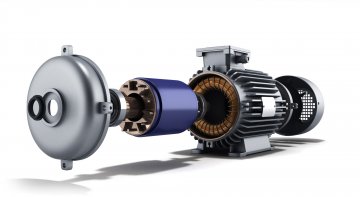Smart Electric Motor: Technology Innovation as a Key Enabler of Energy Efficiency
1. Current Enviroment
Industrial world — as we know it — keeps spinning thanks to electric motors. According to International Energy Agency (IEA), electric motors are responsible for more than half of the global electricity use. Another important fact presented by Asian Development Bank (ADB) study says that share of the Asia-Pacific region on global energy consumption is set to increase to 56% by 2035. Growth in electricity use is led by industrial motors (notably in China).
Electricity consumption levels predicted to increase deserve energy efficient and sustainable approach, smartening up of electric motors and also efforts for tackling inefficiencies.
2. Push, Push, Push
Governments around the world are pushing minimum energy performance standards (MEPS), frameworks, initiatives, regulations, policies. Notable push comes from the side of financial and banking institutions — providing loans, number of support schemes and programs, credit lines for large scale energy efficiency deployment projects. Customer push — demand for intelligent IOT enabled electric motor — comes from repeated and often frustrating experience of production downtime occurrence and their effect on company’s bottom line. Manufacturer push comes from the motivation not only to be able to supply the best in class electric motor, but also increase its efficiency and provide predictive maintenance of a motor at their customer production facilities.
Last but not least — there is also environmental aspect — that requires immediate action. Electric motors emit a total of 6,800 metrics tons of carbon dioxide in a year. A transition to energy-efficient motor systems would reduce the global electricity demand for electric motors by around 20% to 30% by 2030.
3. Technology Push
Connecting piece of all initiatives is the technology. Innovation. We at RVmagnetics are bringing the novel technology — the smallest passive sensor in the world. Thank to its size — our passive contactless sensor — MicroWire — is able to maximize motor efficiency. We can achieve that by measuring real time temperature inside of the motor — allowing us to be aware of Curie temperature limit and get closer to the limit without causing irreversible damage to the motor itself. Result is the intelligent, more efficient solution.
MicroWire sensor — passive unpowered element — enables realtime temperature detection from inside of an electric motor. Powered part — sensing head — conducts the measurement from the outside of the motor casing / chassis — needs to be within a maximum range of 10 cm / 3 inch from the Microwire sensor. Sensing possibilities include temperature, vibration, tensile stress, rotation speed and position of rotor vs. stator.
Significant benefits include performance monitoring, optimizing predictive maintenance, avoiding risk of interrupting production, maintenance optimisation, production downtime reduction, real-time motor health monitoring (temperature, vibration …). Increases efficiency and effectiveness by maximizing the potential of physical limits that can also later lead to motor / chassis size reduction and so much desired power consumption decrease, motor burnout prevention and much more.
In a nutshell: you can achieve higher output with your current engine, or use smaller motors to achieve the same output as before, all with the same level of safety and minimum of engine design changes.

4. Turning Back the Time?
“If the world is to turn today’s emissions trend around, it will need to focus on the emissions that are “locked in” to existing systems says World Energy Outlook 2019.
The most challenging part is to smarten up electric motors that are already in use. Those, that client already uses in every day production. With RVmagnetics MicroWire technology you won’t need to change your existing industrial design. Simple plug & play solution, in most cases implementable during scheduled maintenance.
5. Win for All Stakeholders
Progress and effects of CO2 emissions, reflecting on climate change are enormous and unpredictable. One thing we know for sure is that emissions are not benefiting the stability of global climate. Solution we present also reduces the need of power capacity required for sensing as such.
On one hand — key economic benefit for the client having installed the smart sensor is predictive maintenance — significant reduction of production downtimes. On the manufacturer side — better planning of maintenance / repair and replacement activities.
While all the rest of the world may just breathe the cleaner air…
PS: and while we are at it… are you eager to read the scientific cornerstones of our technology? Means the (magnetic) world to us…


